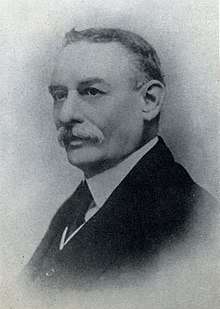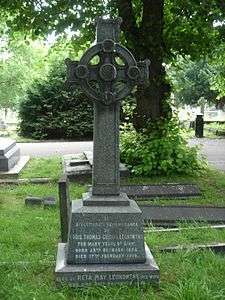Louis T. Leonowens
Louis Thomas Gunnis Leonowens (25 October 1856 – 17 February 1919) was a British subject who grew up and worked in Siam (Thailand). He was the son of Anna Leonowens, famous as a tutor of King Mongkut. Leonowens later served as an officer with the Siamese Royal Cavalry and founded a Thai trading company that still bears his name, Louis T. Leonowens Ltd. He was the basis of a major character in the 1944 novel Anna and the King of Siam, as well as other fictional works based on it.
| Louis T. Leonowens | |
|---|---|
 | |

Early life
Leonowens was the son of Anna Leonowens nee Edwards, an Anglo-Indian who had never visited Britain, and Thomas Leon Owens, an Irish-born, India-raised clerk, who married in India in 1849. The couple left India for Singapore, then part of the Straits Settlements, in 1852.
Louis was born at Lynton, Western Australia,[1] where his father was working for the Commissariat. In 1857, the family moved to Penang, where his father was a hotel manager.[2] His father died in 1859, and his mother moved to Singapore with Louis and his elder sister, telling the British expatriate community there that she was a genteel Welsh woman, the widow of a British army officer who had unfortunately lost her fortune.[3]
His mother's story was believed, and she was invited, in 1862, to teach the wives and children of King Mongkut of Siam (now Thailand). After sending Louis's sister to England to get a British education, his mother took him to Bangkok. He was raised in the Siamese royal palace for nearly six years and was schooled by his mother alongside the royal children, until 1867. He was sent to Europe to complete his education. By 1874, Louis was in the United States with his mother, but he had accumulated debts. He fled the U.S. and was estranged from his mother for 19 years.[3]
Career
In 1881, at the age of 25, he returned to Siam and was granted a commission of Captain in the Royal Cavalry, by King Chulalongkorn.[2]
Leonowens in 1884 left the military and entered the teak trade. He went on in 1905 to found the Louis Thomas Leonowens Company in Siam, which became Louis T. Leonowens Ltd, an international trading company. This company remains a leading exporter of Malayan hardwoods and an importer of building materials and general merchandise.[4]
He became less involved in the operations of the company after 1906 and left Siam for the last time in 1913.[2]
Personal life
Leonowens was married to:
- Caroline Knox (1856–1893), the youngest daughter of Sir Thomas George Knox, British consul-general in Siam from 1868 to 1879, and his wife, Prang Yen, a Siamese noblewoman.[5][6][7][8][9] They had one son, Thomas ("George") Knox Leonowens (1888–1953) and a daughter, Anna Harriett Leonowens (born 1890, Mrs Richard Monahan).[10]
- Reta May (1880–1936) married Leonowens in 1900. They had no children.[11]
Leonowens died in 1919 during the global influenza pandemic. He is buried, with his second wife, in Brompton Cemetery, London.
Film and television portrayals
The young Louis Leonowens has been portrayed by numerous actors and as being from at least three different countries, including the United States, England and Wales:
- Richard Lyon in Anna and the King of Siam (1946);
- Sandy Kennedy in the 1951 musical The King and I, Jake Lucas in its 2015 revival and Graham Montgomery is its 2017 Broadway National Tour;
- Rex Thompson (レックス・トンプソン) in the 1956 musical film version of The King and I;
- Eric Shea in Anna and the King (1971);
- Tom Felton in the film Anna and the King, starring Jodie Foster (1999); and
- Adam Wylie (voice) in the animated film The King and I (1999).
Notes
- Register of Births, Western Australia, no. 3469, 1856
- "Louis T. Leonowens Ltd". louist.co.th. Archived from the original on 2008-05-06. Retrieved 2017-07-31.
- Loos, Tamara. "Review of Bombay Anna... by Susan Morgan, Journal of Historical Biography, vol 5 (Spring 2009), pp. 146–52
- The Times (16 September 1963); p. x, col. A.
- Bradford Smith, "It Was Love, Love, Love", The New York Times, 16 September 1962
- R. J. Minney, Fanny and the Regent of Siam (The World Publishing Company, 1962
- "A Dark Tragedy in Siam: The Execution of Pra Preecah — A Native Nobleman Beheaded for Marrying A British Officer's Daughter—How a Cruel King Can Retain A Grudge For Years—Medieval Horrors in the Nineteenth Century". The New York Times. 12 April 1880.
- W. S. Bristowe, Louis and the King of Siam (Chatto and Windus, 1976)
- Alec Waugh, Bangkok: Story of a City (W. H. Allen, 1970), pages 84-85
- The Wheaton College Archives & Special Collections: Margaret and Kenneth Landon Papers, 1824–2000, "Archived copy". Archived from the original on 2008-07-06. Retrieved 2010-01-31.CS1 maint: archived copy as title (link)
- W. S. Bristowe, Louis and the King of Siam (Chatto and Windus, 1976), p. 101